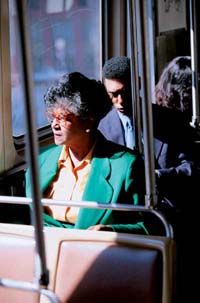If you suffer from motion sickness, you'll do anything to get rid of that queasy feeling, right? Well, following are a few suggestions that just might work.
Pick the right seat. If possible, sit in an area with the smoothest ride, where motion is least likely to be felt in the first place. When making a plane reservation, ask for an aisle seat over a wing. On a train, opt for a car toward the front. Sit in the front seat of an automobile. And on a ship, ask for a cabin toward the center of the vessel.
Avoid standing. The last thing you need when you're trying to keep your stomach settled is to be tossed around during the trip.
Face forward. Choose a seat that faces in the direction you are traveling, so that the forward motion your body feels will match what you see.
Minimize head movements. Try to avoid sudden movements of your head, which can aggravate motion sickness.
Stay up. While you may be tempted to go below when you're feeling queasy on a boat, stay on deck as much as possible, so your eyes can confirm the movement that your body is feeling.
Look off into the distance. Not to daydream, but to focus on a steady point away from the rocky boat, plane, or car. If there isn't a tree or barn or other specific object in the distance to focus on, stare out at the horizon, where the sky meets the earth (or water). Again, this will allow your eyes to see that you are moving -- to match the movement your body feels -- without making you dizzy, the way that watching telephone poles or mile markers whizzing by can make you feel.
Leave your reading at home. If you read in a car, your eyes stay fixed on a stationery object, yet your body feels the motion of the car -- again setting up that sensory contradiction. Instead, focus on the road in front of you or at a distant object so all your senses can confirm that you are on the move.
Volunteer to drive. Drivers are so busy watching the road that they're less apt to get carsick.
Eat a little or don't eat at all. Sometimes eating helps, sometimes it doesn't. Experiment to see what works for you. About an hour before you leave, eat some plain crackers or a piece of bread or toast. If it makes you feel worse, don't eat next time -- keep your stomach calm and empty, in case you should start to get nauseated.
Avoid heavy foods and odors. The smell of spicy or greasy foods and strong odors can prompt motion sickness before or during a trip. So skip the stop at the roadside diner.
Say no to alcohol. Avoid alcoholic beverages before and during a trip. It can worsen motion sickness.
Stay calm, cool, and collected. Sometimes, just the thought of getting sick can make you sick. The same goes for those who are anxious about what they're about to do, like flying in a plane or riding in a boat. Try to stay as calm and relaxed as possible. Take a few deep breaths, and tell yourself that you will not get sick.
Try over-the-counter remedies. Antihistamines, such as Dramamine, Bonine, and Marezine, should be taken at least an hour before the trip for maximum effectiveness. Always check the label for warnings and possible side effects, such as drowsiness or blurred vision, and take necessary precautions, such as not driving a car.
Stay away from others who are sick. The power of suggestion is very strong, especially if you have a tendency to get a bit "green" yourself. As callous as it may sound, let someone with a sturdier stomach tend to the sick; you should be looking at the horizon or at another steady point in the distance.
Whether it's from a plane, train, or automobile, motion sickness can be crippling to those affected by it. Follow the tips outlined in this article to help get rid of that queasy feeling before it begins.
©Publications International, Ltd.
This information is solely for informational purposes. IT IS NOT INTENDED TO PROVIDE MEDICAL ADVICE. Neither the Editors of Consumer Guide (R), Publications International, Ltd., the author nor publisher take responsibility for any possible consequences from any treatment, procedure, exercise, dietary modification, action or application of medication which results from reading or following the information contained in this information. The publication of this information does not constitute the practice of medicine, and this information does not replace the advice of your physician or other health care provider. Before undertaking any course of treatment, the reader must seek the advice of their physician or other health care provider.
The brand name products mentioned in this publication are trademarks or service marks of their respective companies. The mention of any product in this publication does not constitute an endorsement by the respective proprietors of Publications International, Ltd. or HowStuffWorks.com, nor does it constitute an endorsement by any of these companies that their products should be used in the manner described in this publication.

